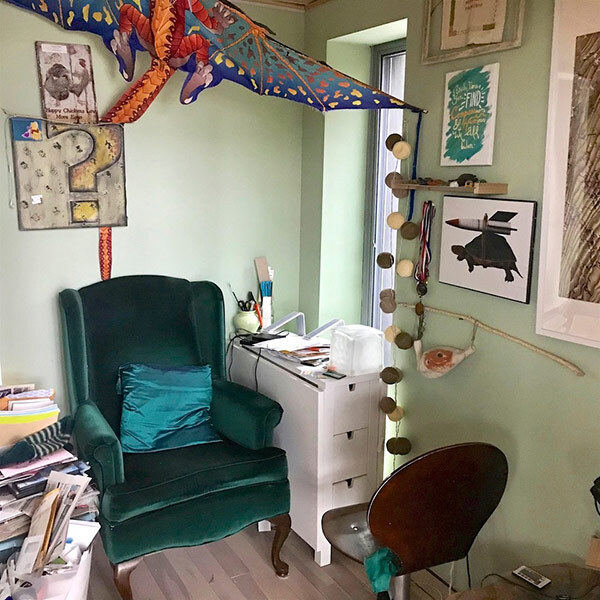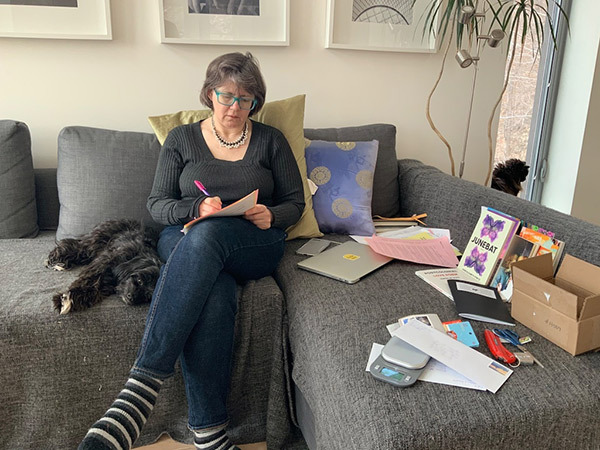Pearl Pirie’s Writing Space
By Pearl Pirie
My real writing room is between my ears, and on nearest piece or paper, or lately something digital since a broken wrist has wreaked havoc with my already iffy handwriting.
I write wherever I can find my laptop or phone. I may have to lift a cat or dog to find them, or I may have left them (them the device not the animal) to charge by the fire that was burning in the morning, or by where I was cooking in the evening. I think scientists call this search “environmental enrichment”.
In my home office I have a rocket-booster turtle to remind me of natural speed, and the comedy of trying to go faster than I can. A metal question mark reminds, does it matter, why, why, why dig deeper. Lenticular prints and various lenses that show things change with your perspective, and an array of things that represent transformation: rubber tadpole and frog, wood shavings and petrified stone, a snakeskin. Things of mortality and interest such as a cow’s tooth, a dragonfly, deer antlers. And things to play with that please me: a music box, hand drums, beaver sticks, pretty stones and feathers. And prints I enjoy looking at: a Gaudi roof, Kirk and Spock and Manahil Bandukwala’s man with mango.

I can tuck myself in there in the dimness, with no movement in my peripheral vision and no internet. I can sit with my stash of all the relevant reference books. To my detriment there gets to be a detritus of papers and book piles which can dominate the space. Physical clutter is mental clutter.
For editing I need a clear, open well-lit space. As Jonathan Ball said, write at night, edit by light. That in my case is usually out on the couch with the dog cuddled in, as a live demonstration of calmness.
Blankets and my best friend are my favourite parts of the editing space. They are key. When I fall into work I forget time, space and body. I get cold and cramped, until the cat biting my feet, the dog nosing at me, and Brian speaking, remind me that meals and outside exist.
They all herd me to the important matters of eating and walking. Ideally I’ll rouse myself sooner before I lose circulation and get dizzy from concentration, and before I keel over overwhelmed because I looked at a screen too long, and/or forget to eat, drink, rest and breathe. On high anxiety days, the nested causalities means all I get to do is gear down and let myself find equilibrium. Nested causalities being I want X. Y has to happened before X. But first I need to do Z. In order to do Z I need to do A. Then I just get crestfallen then nap on a lap.
I can tuck myself in there in the dimness, with no movement in my peripheral vision and no internet. I can sit with my stash of all the relevant reference books.
What writing space tips would you offer to writers like yourself?
Stretch breaks. When pain takes you down, you can’t be yourself, or anything but useless. At least I can’t. A couple hours of exercise a day will loosen breath, body and clenched mind. We aim to walk 2-5km each day. Forest time is healing. Not a city forest. They practically hiss with their compacted roots, damaged limbs and far-off root network, but out among old trees, as undisturbed and old as possible. Or whatever place is holy and grounding to you to not do but be.

Pearl Pirie’s fourth collection, footlights, comes in the fall 2020 from Radiant Press. Her newest chapbook is Not Quite Dawn (Éditions des petits nuages, March, 2020). Her epistle haibun chapbook, Water loves its bridges: Letters to the dead, is due out in Dec 2020 from The Alfred Gustav Press by subscription.
Photos courtesy of Pearl Pirie.

